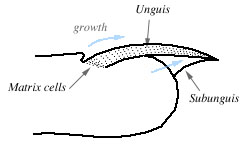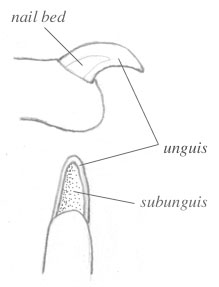Claws are products of the skin, and are found at the tips of the digits of most four-legged animals. Claws consist of thick deposits of keratinized, flattened epithelial cells. Keratin is a fibrous protein that is also a major consistuent of hair, the outer layer of skin, reptile scales, and bird feathers.
A layer of cells called matrix cells, located at the base of the claw, produces new claw. The claw grows outward from the matrix, such that the newest claw cells are located at the base of the claw and the oldest cells at the tip.
|
|
|
Cross-section of a mammalian claw. The claw grows outward (blue arrows) from proliferating matrix cells at its base. Adapted from Kardong 1995. |
- The dorsal unguis (also called the nail plate). This is the hard, external part of the claw. In the unguis, the grain of the keratin is perpendicular to the direction of growth and is arranged in layers at an oblique angle.
- The ventral subunguis (also called the sole
plate). This is the soft, flaky underside of the claw. The
grain of the keratin is parallel to the direction of growth, and
softer than that of the unguis. The subunguis is continued by a
cusion-like pad.
|
|
|
Drawing from life of a side view (top) and bottom view (bottom) of a rat's claw. |
The rat's claw has a sensitive pink "core" or "quick," called the nail bed, which you can see through the semi-transparent keratin. In humans, the nail bed is the flat pink part of the fingernail.
Claws are found in most four-legged animals. Primates have
flattened versions of these claws, called nails. In fact, primate
fingernails and toenails may actually be fetal versions of claws.
Anatomically, our unguis is flat and our subunguis is very reduced --
just a thin band of softer material under the outer edge of the nail.
Ungulates, like horses and cows, have an especially thick version of
the claw called a hoof.
Further reading:

